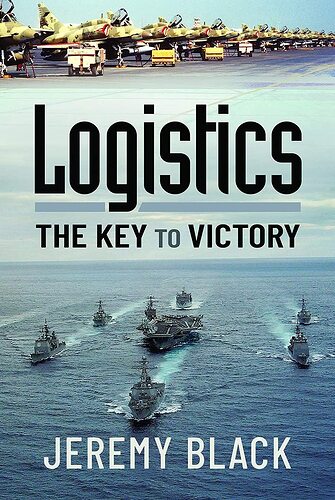Looking for a good read? Here is a recommendation. I have an unusual approach to reviewing books. I review books I feel merit a review. Each review is an opportunity to recommend a book. If I do not think a book is worth reading, I find another book to review. You do not have to agree with everything every author has written (I do not), but the fiction I review is entertaining (and often thought-provoking) and the non-fiction contain ideas worth reading.
Book Review
What Military Professionals Talk About
Reviewed by Mark Lardas
October 24, 2021
Logistics: The Key To Victory,” by Jeremy Black, Naval Institute Press, 2021, 240 pages, $42.95 (Hardcover )
In a 1979 interview Marine Corps General Robert Barrow stated “Amateurs talk about strategy and tactics. Professionals talk about logistics.” History has demonstrated its applicability many times.
“Logistics: The Key To Victory,” by Jeremy Black, is a study of the role logistics played in warfare throughout history. Most prior books on logistics focused on its tactical aspects – how to get supplies where they are needed. Black’s book examines the strategic role of logistics.
Black looks at logistics through a new lens. Often logistics is treated as if it emerged during the Napoleonic Era (the late 18th and early 19th centuries), and is relevant only thereafter. Black starts at the beginning, showing the importance of logistics as civilization emerged. Black demonstrates the dominance of logistics in ancient times, can be captured in two words: campaign season. Ancient warfare was constrained by the availability of food and water, from Ancient Egypt onwards.
He also expands his inquiry geographically. Most studies focus on the western world, Europe and North America, examining the rest of the world only where Western warfare impinges on Africa, Asia and South America. Black presents the effects of logistics – both its limitations and capabilities – throughout the world and throughout history. He shows how great empires outside the west, including the Mongols, the Persians and the Chinese, rose and fell due to logistics.
He also shows how logistics grew in complexity. Logistics is centered on consumables. Although logistics includes items such as uniforms and weapons, these were typically not a major driver, except at the beginning of a war, when armies and navies had to be equipped. Prior to the introduction of gunpowder battlefield logistics focused on ensuring troops had sufficient food and water. Shelter and equipment could be carried by troops with a relatively small baggage train.
Gunpowder introduced a new consumable, and weapons too heavy to move easily. Gunpowder and cannons could be manufactured in the field or gathered from the countryside. Supply trains grew dramatically. Mechanical power from steam to internal combustion added fuel to the logistics equation. It, too had to be moved to the battlefield. Black shows the influence of the growth of the logistical train on warfare.
While (as the recent Afghanistan debacle shows) superior logistics cannot guarantee victory, Black illustrates how inferior logistics can doom a war effort. “Logistics” is not light reading. Yet for anyone interested in strategy it is a valuable book.
Mark Lardas, an engineer, freelance writer, historian, and model-maker, lives in League City. His website is marklardas.com .
